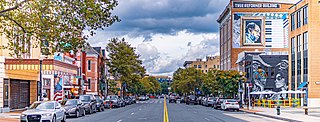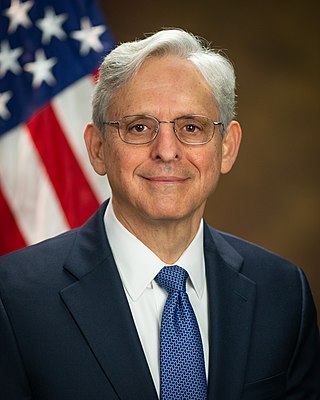Related Research Articles

Washington, D.C., formally the District of Columbia and commonly known as Washington or D.C., is the capital city and federal district of the United States. The city is on the Potomac River, across from Virginia, and shares land borders with Maryland to its north and east. It was named for George Washington, the first president of the United States. The district is named for Columbia, the female personification of the nation.

Potomac is an unincorporated community and census-designated place in Montgomery County, Maryland, United States. As of the 2020 census, it had a population of 47,018. It is named after the nearby Potomac River. A part of the Washington metropolitan area, many Potomac residents work in nearby Washington, D.C., and Northern Virginia.

Ridgeley is a town in Mineral County, West Virginia, United States, and part of the Cumberland Metropolitan Statistical Area. The population was 590 at the 2020 census.

Chevy Chase is the colloquial name of an area that includes a town, several incorporated villages, and an unincorporated census-designated place in southern Montgomery County, Maryland; and one adjoining neighborhood in northwest Washington, D.C. Most of these derive from a late-19th-century effort to create a new suburb that its developer dubbed Chevy Chase after a colonial land patent.

Germantown is an urbanized census-designated place in Montgomery County, Maryland. With a population of 91,249 as of the 2020 census, it is the third-most populous community in Maryland, after Baltimore and Columbia. Germantown is located approximately 28 miles (45 km) outside the U.S. capital of Washington, D.C., and is an important part of the Washington metropolitan area.
Go-go is a subgenre of funk music with an emphasis on specific rhythmic patterns, and live audience call and response.

The First Battle of Bull Run, called the Battle of First Manassas by Confederate forces, was the first major battle of the American Civil War. The battle was fought on July 21, 1861, in Prince William County, Virginia, just north of what is now the city of Manassas and about thirty miles west-southwest of Washington, D.C. The Union Army was slow in positioning themselves, allowing Confederate reinforcements time to arrive by rail. Each side had about 18,000 poorly trained and poorly led troops. The battle was a Confederate victory and was followed by a disorganized post-battle retreat of the Union forces.

Washington, D.C., has been home to many prominent musicians and is particularly known for the musical genres of Jazz, Rhythm & Blues, bluegrass, punk rock and its locally-developed descendants hardcore and emo, and a local funk genre called go-go. The first major musical figure from District of Columbia was John Philip Sousa, a military brass band composer. Later figures include jazz musicians, such as Duke Ellington, Charlie Rouse, Buck Hill, Ron Holloway, Davey Yarborough, Michael A. Thomas, Butch Warren, and DeAndrey Howard; soul musicians, including Billy Stewart, The Unifics, The Moments, Ray, Goodman & Brown, Van McCoy, The Presidents, The Choice Four, Vernon Burch, guitarist Charles Pitts, and Sir Joe Quarterman & Free Soul.

The Ashcan School, also called the Ash Can School, was an artistic movement in the United States during the late 19th-early 20th century that produced works portraying scenes of daily life in New York, often in the city's poorer neighborhoods.

Merrick Brian Garland is an American lawyer and jurist who serves as the 86th United States attorney general. He previously served as a circuit judge of the United States Court of Appeals for the District of Columbia Circuit from 1997 to 2021. In 2016, President Barack Obama nominated Garland to the U.S. Supreme Court, but the Republican-led U.S. Senate effectively blocked Garland's appointment.

The Hot Zone: A Terrifying True Story is a best-selling 1994 nonfiction thriller by Richard Preston about the origins and incidents involving viral hemorrhagic fevers, particularly ebolaviruses and marburgviruses. The basis of the book was Preston's 1992 New Yorker article "Crisis in the Hot Zone".

Christina Rene Hendricks is a British-American actress and former model. With an extensive career on screen and stage, she has received various accolades, including six Primetime Emmy Award nominations, two Screen Actors Guild Awards, and two Critics' Choice Awards for Best Supporting Actress in a Drama Series. She is known for her role as Joan Harris in the critically acclaimed AMC drama series Mad Men. In 2010, a poll of female readers taken by Esquire magazine named her "the sexiest woman in the world". She was also voted "Best Looking Woman in America".

Bristow is an unincorporated community of Prince William County about 30 miles from Washington, D.C. It is situated between Manassas, Virginia and Gainesville, Virginia. As of 2014, the total population was 29,346, a 287% increase since 2000. The Bristow community is formally included in the Linton Hall, Virginia census-designated place (CDP)

The culture of Washington, D.C. is reflected in its status as the capital of the United States and the presence of the federal government, its large Black population, and its role as the largest city in the Chesapeake Bay region. The presence of the U.S. federal government, in particular, has been instrumental in developing numerous cultural institutions throughout the city, such as museums and performing arts centers. The city's historic Black population has also helped drive cultural activities and artistic pursuits. During the early 20th century, for example, Washington's U Street Corridor became an important center for African American culture.

Katharine Elizabeth Dopp was one of the foremost American educators at the turn of the 20th century, and one of the first to advocate the involvement of business in education. She wrote a series of textbooks on anthropology and economics which were widely used in the public schools of Wisconsin, Illinois and Utah, as well as nationally circulated studies on the same subjects, and children's books.

A cave dweller, or troglodyte, is a human who inhabits a cave or the area beneath the overhanging rocks of a cliff.

Mark Twain Cave — originally McDowell's Cave — is a show cave located near Hannibal, Missouri. It was named for author Mark Twain whose real name was Samuel Langhorne Clemens. Clemens lived in Hannibal from 1839 to 1853, age 4 to 17. It is the oldest operating show cave in the state, giving tours continuously since 1886. Along with nearby Cameron Cave, it became a registered National Natural Landmark in 1972, with a citation reading "Exceptionally good examples of the maze type of cavern development." The cave — as "McDougal's Cave" — plays an important role in the novel The Adventures of Tom Sawyer (1876) by Mark Twain and was renamed in honor of the author in 1880.
Christina McDowell is an American author, actress, and filmmaker, best known for her debut novel, After Perfect.

Arthur Glenn Froe was an American lawyer and politician. He was appointed by President Warren G. Harding as the Recorder of Deeds for the District of Columbia, and served in this position from 1922 to 1930 during the presidential administrations of Harding, Calvin Coolidge, and Herbert Hoover.

People of Irish descent form a distinct ethnic group in Washington, D.C., and have had a presence in the region since the pre-American Revolution period.
References
- ↑ Gamarekian, Barbara (March 26, 1985). "The Lives of the Cave Dwellers". The New York Times. Retrieved May 28, 2021.
- ↑ Conroy, Sarah Booth (June 14, 1987). "D.C.'S FIRST FAMILIES". The Washington Post. Retrieved May 28, 2021.
- ↑ Peterson, Britt (March 2, 2015). "Why Washington's Fanciest Families Liked to Be Known as Neanderthals". Washingtonian. Retrieved May 28, 2021.
- ↑ White, William C. (April 21, 1939). "The Cave-Dweller" . The New Yorker. Retrieved 28 May 2021.
- ↑ Kelly, John (January 9, 2021). "Going spelunking with Washington's blue-blooded 'cave-dwellers'". The Washington Post. Retrieved May 28, 2021.
- ↑ Charles, Ron (May 24, 2021). "Christina McDowell's satire 'The Cave Dwellers' belongs among the essential books about Washington" . The Washington Post. Retrieved May 28, 2021.